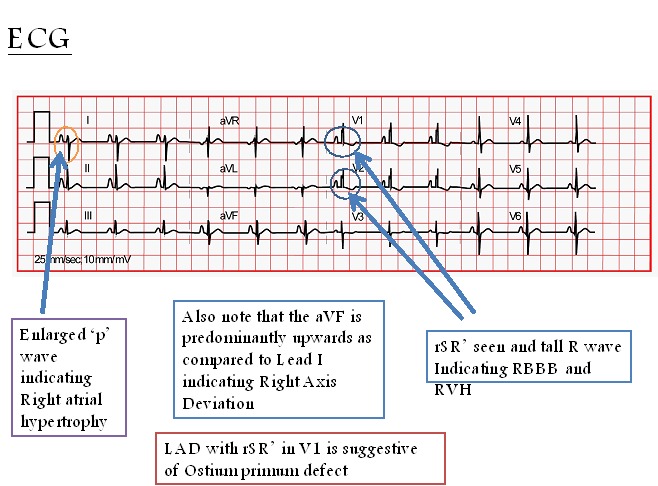Atrial septal defect electrocardiogram
|
Atrial Septal Defect Microchapters | |
|
Treatment | |
|---|---|
|
Surgery | |
|
| |
|
Special Scenarios | |
|
Case Studies | |
|
Atrial septal defect electrocardiogram On the Web | |
|
American Roentgen Ray Society Images of Atrial septal defect electrocardiogram | |
|
Risk calculators and risk factors for Atrial septal defect electrocardiogram | |
Editor-In-Chief: C. Michael Gibson, M.S., M.D. [1]; Associate Editor(s)-In-Chief: Priyamvada Singh, M.B.B.S. [2]; Cafer Zorkun, M.D., Ph.D. [3] Assistant Editor(s)-In-Chief: Kristin Feeney, B.S. [4]
Overview
Electrocardiogram may be used as a diagnostic tool in the evaluation of an atrial septal defect. ECG findings associated with an atrial septal defect may include right atrial enlargement, right-axis deviation, PR prolongation (first degree heart block), right bundle branch block, right ventricular hypertrophy, left and right axis deviation, atrial fibrillation, atrial flutter, and junctional rhythms.
Electrocardiogram
The ECG findings in atrial septal defect vary with the type of defect present.
- It may be normal with an uncomplicated ASD and a small shunt.
- Individuals with atrial septal defects may have a prolonged PR interval (a first degree heart block). The prolongation of the PR interval is probably due to the enlargement of the atria that is common in ASDs and the increased distance due to the defect itself.
- Incomplete and less frequently complete Right Bundle Branch Block (RBBB) is often present. Right Ventricular Hypertrophy (RVH) with strain suggests onset of pulmonary hypertension or associated pulmonic stenosis.The QRS complex may be slightly prolonged and has a characteristic rSr' or rsR' pattern that is contributed to the disproportionate thickening of the right ventricular outflow tract (the last portion of the ventricle to depolarize).
Lesion specific electrocardiogram findings
- Ostium secundum ASD- Patients with ostium secundum ASDs often develop atrial fibrillation or atrial flutter, and this occurs with a higher incidence with increasing age and with pulmonary hypertension. 2 out of 3 patients with an ostium secundum ASD have right axis deviation, incomplete right bundle-branch block.
- Ostium primum ASD - The first degree heart block is found to happen more frequently with ostium primum ASD compared to the other types due to the involvement of 'Bundle of His' present in the close proximity of the defect. Both of these can cause an increased distance of internodal conduction from the SA node to the AV node.[1] Ostium primum ASDs are associated with a marked superior left axis deviation.
- Sinus venosus ASD - Individuals with a sinus venosus ASD exhibit a left axis deviation of the P wave (not the QRS complex). It is often associated with low atrial and junctional rhythms, abnormal P-wave axis.
- Familial ASD- Complete heart block may be present in association with familial ASD [2].
The 12 lead EKG below shows the rSR' pattern in V1 (R' greater than S with T wave inversion which is commonly seen in volume overload in Right Ventricular Hypertrophy)

The 12 lead EKG below shows right atrial enlargement and an rSR' pattern in V1 (R' greater than S with T wave inversion which is commonly seen in volume overload in Right Ventricular Hypertrophy))

References
- ↑ Clark E, Kugler J (1982). "Preoperative secundum atrial septal defect with coexisting sinus node and atrioventricular node dysfunction". Circulation. 65 (5): 976–80. PMID 7074763.
- ↑ Bizarro RO, Callahan JA, Feldt RH, Kurland LT, Gordon H, Brandenburg RO (1970). "Familial atrial septal defect with prolonged atrioventricular conduction. A syndrome showing the autosomal dominant pattern of inheritance". Circulation. 41 (4): 677–83. PMID 5437412.